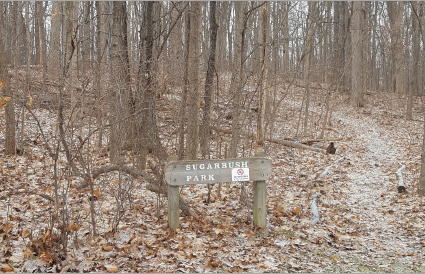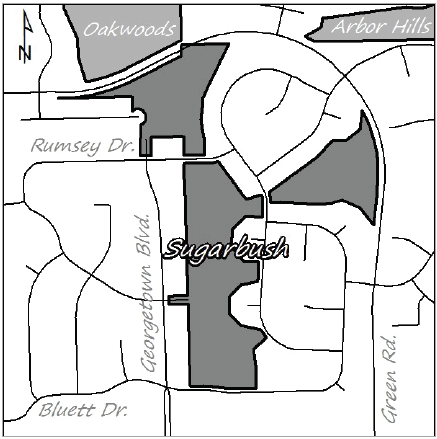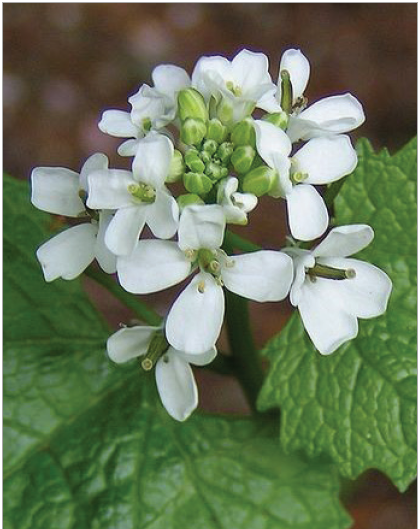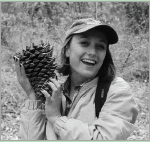Natural Area Preservation News
Protecting and restoring Ann Arbor's natural areas and fostering an environmental ethic among its citizens.
Volume 22, Number 1
Spring 2017
- Park Focus: Sugarbush Nature Area
- Coordinator's Corner: Welcome to the Family!
- Citizen Science in the Ann Arbor Parks
- Garlic Mustard Weed-Out Day, May 13th
- Staff Updates and other NAPpenings
Park Focus: Sugarbush Nature Area
Drew Zawacki, Conservation Worker
One of my favorite things about living in Ann Arbor is the number of parks we have in our community. It seems like wherever you go, there’s bound to be a natural area nearby. When I started working for NAP, I was amazed by how many parks I had driven by for years, completely unaware that they were there. One of these awesome natural areas is Sugarbush Park. Although it is small, this park has a unique assortment of plants, including several rare species.
 Sugarbush: The woods at the south end of the park is over 80 years old, and it’s likely that the land there was never plowed.
Sugarbush: The woods at the south end of the park is over 80 years old, and it’s likely that the land there was never plowed.
Sugarbush is a quiet neighborhood park south of Green Road in the northeast corner of town. It covers 25.6 acres, including a small natural area at the north end, between Green Road and Rumsey Drive. South of Rumsey is the developed area of the park, which extends east across Yellowstone Drive. This area includes a ball diamond, playground, and a couple of tennis courts. At the southern end of the park, bordered by houses on Georgetown Boulevard, and Bluett and Yellowstone Drives, is a natural area with high diversity of native plants. Part of how we protect these important plant species is through the use of controlled burns.
Last November, NAP’s prescribed burn crew was able to conduct a burn in Sugarbush for the first time. NAP staff expect the reintroduction of fire into this area to benefit fire-adapted native wildflower species, and they’ll respond with more abundant blooms this spring than in the past. If you are like me and wildflowers are one of your favorite things about spring, I urge you to stop by and see which ones are out at Sugarbush Park this year. Some spring wildflowers that you might encounter there include bloodroot, May-apple, and both common trillium and uncommon (and sometimes deep red) drooping trillium. Later in the spring, you may be lucky enough to find some rarer plants like wood-betony and black snakeroot.
One of the things that sets Sugarbush apart from the other parks in Ann Arbor is its pawpaw grove. Pawpaws are small trees that grow under taller trees and along forest edges, typically in moist areas. They grow to a height of 15-25 feet and form groves when a single plant sends out root suckers. Pawpaw trees have leaves that are distinctively large and obovate (widest just behind the leaf tip), dark green, and often hang down like “dog ears” from the twig. Their leaves have a tropical look to them, and they are hard to confuse with other leaves once you get to know them. When present, the fruit of the pawpaw is definitely the most distinctive characteristic of this plant. A pawpaw fruit looks like a short, fat banana, and are the largest tree fruits native to North America. Pawpaws usually ripen around late September or October.
Blue ash or four-angled ash is another unusual woody species that can be found at Sugarbush. It receives these names from the blue dye that was made from its inner bark, and from its twigs which are usually more square than round. We only have this species in one other park in Ann Arbor. Another notable tree that can be found at Sugarbush is flowering dogwood. These small native trees have large white flowers in the spring.
Plants are not the only interesting things that can be found
in Sugarbush Park. In a small vernal pool in the southwest corner of the park, whole communities of invertebrates and amphibians have evolved to use this temporary aquatic habitat. The Spotted Salamander and the Red-Backed Salamander are two of the five species of salamander living in the Ann Arbor area, and both have been found at Sugarbush. Spotted Salamanders lay their eggs in the water, where their young become top predators in these small ecosystems. If you’re interested in learning more about salamanders or other wildlife in our parks, you can join NAP’s volunteer wildlife surveys. We need help keeping track of salamanders, frogs, turtles, birds, and butterflies in our parks and nature areas. Survey kickoffs are in March and April. Check the calendar in this issue for details.

Coordinator's Corner: Welcome to the Family!
Dave Borneman, Natural Area Preservation Manager
Long-time readers will know that whenever something major happens in my personal life, it usually finds its way into this column. So it would be odd if I didn’t at least mention the fact that I got engaged in December! A big “thanks” to those of you who have, or will, congratulate me and wish us well. Of course, I’m pretty excited.
But what I really wanted to talk about here was the wonderful, warm welcome that I’ve received from my new family. My future father-in-law even sent me a gift and a nice card that started with the words, “Welcome to the family.” What a kind thing to do. It’s always a little scary to venture down a new path in life, especially one that requires such a big commitment. It’s really nice to know that, as I start out on this new adventure, I’m being welcomed, supported, and encouraged by those whom I am joining.
You see where I’m going with this. Maybe you’ve been checking out a variety of volunteering opportunities around the area. Maybe you’ve been wanting to keep your options open and not commit to any single organization. Maybe you aren’t sure how long of a commitment you’re ready to make, and would prefer to just take it a day at a time. That’s all OK. Do what feels right to you. NAP will welcome any volunteer effort that you are able to grant us. Come to a single workday by yourself, or bring your entire family, or your co-workers, or your neighbors, or your club. Or get trained to be a Workday Leader and help us lead some huge workdays with hundreds of people. Come to our burn training and be part of the burn crew this spring, carrying around backpacks filled with water; or just come and do “smoke monitoring” for us. Volunteer to be a Park Steward in your favorite natural area. Join our frog and toad survey, or our salamander survey, or be a Turtle Steward. Volunteer for the Breeding Bird Survey or the Butterfly Survey. Sign up to go take pictures in the parks and be a Photo Monitor. Or share your administrative skills and come volunteer in the office.
We have volunteer opportunities to match whatever level of commitment you are ready to make. Maybe you’re still in the early stages of volunteering and are most interested in exploring a wide range of volunteer opportunities. Or perhaps you are now ready to make a deeper commitment with NAP. Maybe you’re ready to sign up as a long-term park steward in your favorite natural area. Wherever you are along that continuum, NAP is here to offer training, support, encouragement, and whatever else you need to make your volunteer experience as satisfying and worthwhile as possible. We’d love to have you get more involved!
Welcome to the family!
Citizen Science in the Ann Arbor Parks
George Hammond, Inventory Staff
Have you noticed anything outside today? A passing bird? Buds on a branch? That’s valuable information! As the climate changes and ecosystems respond, scientific studies across the country are eager for volunteers to help them collect more information about these changes. Smart phones and internet access make it easier than ever for you to help contribute to conservation and ecology. Many projects need information that anyone can collect, and you’ll be learning even while sharing what you find. There are valuable data to be found just outside your home, but we hope you will look in our parks too! Here are a few of the many projects you can get involved in, and places to find more
Happening now: Birds! While some plants and animals are dormant now, the birds are active and fun to watch. eBird (www.ebird.org), run by the Cornell University Laboratory of Ornithology, collects bird observations from around the world. They have millions of observations already, and are finding important patterns. You can use their system to record and report what you see. There are also special programs for folks who feed birds (www.feederwatch.org), or can check on nests (www.nestwatch.org). Savvy bird-watchers who know their bird calls are strongly encouraged to join NAP’s own Breeding Bird Survey. BBS volunteers focus on the birds of one or more assigned parks, and do walking surveys and point counts in the spring, using eBird to record the birds they see and hear. The survey kickoff is the evening of April 13. See the NAP calendar in this issue for details.
Coming soon: Budburst and Herpmapping! Project Budburst
(www.budburst.org) is one of the easiest citizen science projects to get involved in. No expertise is necessary, and you can do it in your yard neighborhood or in our parks! Volunteers follow the life stories of plants – when do they bloom? When do leaves open? The timing of these events change with the climate and they are important for predicting the future of our ecosystems. This project has lots of opportunities for kids, and plenty of support for teachers.
Herp mapping (“herp” is zoology shorthand for reptiles and amphibians) involves locating these animals and recording their locations. NAP has volunteer surveys of frogs, salamanders, and turtles. The frog and salamander surveys kick off on March 11, and turtles on April 15. Frogs have distinct calls, just like birds, and we’ll help you learn them as part of the training. You can use the Herpmapper app on a mobile device, or www.herpmapper.org online, to record your observations.
As plants leaf out and insects emerge, it’s time to watch for invasive species. The Midwest Invasive Species Information Network is hosting three citizen science programs: Eyes On The Forest (volunteers monitor “sentinel trees” that they choose), MI-Mast (notes production of native wild fruits and nuts that are crucial foods for wildlife) and the Backyard Beetle Project (build a simple trap that collects and preserves bark beetles for experts to study). www.misin.msu.edu.
You can focus on more lovely (and mostly native) insects by joining the NAP Butterfly Survey, in partnership with the statewide Michigan Butterfly Network. Volunteers survey routes in parks, and report their data on the Butterfly Network site. The kickoff is on May 6 (details in our calendar) and more information and resources can be found on the Michigan Butterfly Network site: www.michiganbutterfly.org.
These are just a few of the many citizen science projects that you might enjoy! We’ve focused on nature observation, but there are others that are more analytical. SciStarter is a great site that compiles hundreds of citizen science opportunities around the country. www.scistarter.com.
There are lots of opportunities for you to be a citizen scientist in our parks. We hope you’ll get involved!
19th Annual Garlic Mustard Weed-Out Day
Saturday, May 13, 9 a.m. to noon
Garlic Mustard Weed Out Day has been an annual tradition since 1999! On the same day, volunteers hand-pull invasive garlic mustard in natural areas all around Ann Arbor! Garlic mustard is an aggressive Eurasian species which can quickly crowd out native plant species and decrease natural diversity in the woods. Identifying and pulling garlic mustard is fun and easy for all ages, making this a great volunteer opportunity for families. Please wear long pants and closed-toe shoes. All minors must present a completed release form, and should be accompanied by a guardian. Tools, snacks, and know-how provided.

Participating parks:
• White Oak - Meet at the park entrance on White Oak Drive.
• Hannah - Meet at the west end of Bath Street, off 7th, just north of
West Huron Street.
• Black Pond Woods – Meet at the park entrance on Tibbits Court, off of Pontiac Trail.
• Marshall - Meet in the parking lot off Dixboro Road, north of Plymouth Road.
• Riverwood - Meet near the park sign on Riverwood Drive, just west of Newport Road.
• Sunset Brooks - Meet at the park entrance on Sunset Road, at the end of Brooks Street.
We Need Your Assistance!
Central Michigan University graduate student Stephanie Weems is partnering with NAP to research volunteer recruitment and diversity. We hope that this research will help us better understand how to engage and enhance the environmental ethic of all of the citizens of Ann Arbor. Please help in this endeavor by using the link below to participate in a survey about your volunteer experience.
Your participation is anonymous and greatly appreciated! www.surveymonkey.com/r/63cq5jm.
Society for Ecological Restoration - Midwest/Great Lakes Chapter
The Ninth Annual Meeting of the Midwest-Great Lakes Chapter of the Society for Ecological Restoration will be held in Grand Rapids, Michigan from March 24-26, 2017. This year’s meeting theme is Assembling the Restoration Community.
Details at chapter.ser.org/midwestgreatlakes/current-meeting.
NAPpenings
Thank you!
Many thanks to the groups who volunteered with NAP recently. We could not make such a difference without you!
• Ann Arbor ’04 Wolves Hockey Team
• Ann Arbor Spartans MSU Alumni Chapter
• Circle K, UM
• Delta Sigma Phi, EMU
• Delta Zeta, EMU
• Engineering Global Leadership, UM
• Go Like the Wind Montessori Schools
• Health Science Scholars Program Service Committee, UM
• Kappa Theta Pi, UM
• Michigan Community Scholars Program, UM
• Michigan Connections Academy
• Michigan Running Club, UM
• Music Matters, UM
• Sigma Chi Pledge Class of 2016, UM
• Youth Volunteer Corps
Staff Update
Farewell...

Erin Todd
Thank you to everyone at NAP for making my time on the field crew interesting and teaching me so many new things. I am grateful that I got to spend my field season improving the natural areas of beautiful Ann Arbor, which I consider my home. But now it is time for me to seek out new adventures on the west coast and I am relocating to Oakland, California. What I will miss most of all is the craziness of burn season and I will never forget the dedication of our volunteers and park stewards.
Editor’s note: Erin recently let us know that she is now working as a science tutor for an Oakland middle school. Kudos Erin!
Welcome...
 Alex Sasyk
Alex Sasyk
I graduated with a Bachelor’s of Science from Grand Valley State University in Natural Resource Management with a minor in Biology. After learning the values and aesthetics of environments and ecosystems, I decided that I want to focus my career on conserving and restoring them in areas needed. I was excited to hear Ann Arbor does so much in conservation and restoration, and I am overwhelmingly excited to work for Natural Area Preservation and the City of Ann Arbor.
 Amy Wells
Amy Wells
My name is Amy Wells and I’m a graduate of the University of Michigan, with a degree in Plant Biology. As someone who has always loved exploring and protecting Michigan’s natural areas, I’m thrilled to be joining the NAP Crew! I’ve worked for Matthaei Botanical Gardens and Nichols Arboretum as a natural areas intern, and also as a landscape foreman for a private gardening company. What I enjoy most about all these jobs is seeing the dramatic changes in landscapes as I remove weeds and invasive species to make way for gorgeous native plants and flowers. I’m looking forward to a great burn season this spring, and the wildflower blooms to follow!
